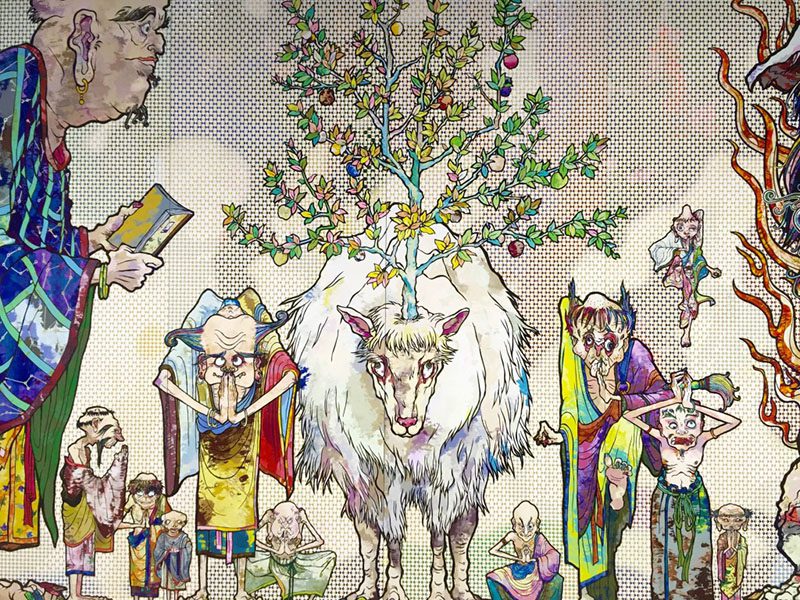ART-TRIBUTE:Takashi Murakami-500 Arhats
 Born in Tokyo in 1962, Takashi Murakami is one of the most influential and acclaimed artists to have emerged from Japan in the late 20th century, creating a wide-ranging body of work that consciously bridges fine art, design, animation, fashion, and popular culture. Often hi is named as the next Andy Warhol, like him, he fuses high and low, pulling imagery from consumer culture to produce visually arresting, highly original work. He is vigorously, ingeniously self-promotional.
Born in Tokyo in 1962, Takashi Murakami is one of the most influential and acclaimed artists to have emerged from Japan in the late 20th century, creating a wide-ranging body of work that consciously bridges fine art, design, animation, fashion, and popular culture. Often hi is named as the next Andy Warhol, like him, he fuses high and low, pulling imagery from consumer culture to produce visually arresting, highly original work. He is vigorously, ingeniously self-promotional.
By Dimitris Lempesis
Photo: Mori Museum Archive
Takashi Murakami studied traditional Japanese painting at the Tokyo National University of Fine Arts, where he was trained in the school known as Nihonga, a 19th Century mixture of Western and Eastern styles. After completing his studies, he increasingly displayed his works in solo and group exhibitions, making his European debut in 1995 in “Trans Culture”, held at the 46th Venice Biennale. Trained in traditional Japanese art, Murakami saw similarities between the flat composition of Japanese painting and the simplified aesthetics of anime and manga. His style, which emphasized two-dimensional forms and bold, striking imagery, gave birth to an artistic movement known as “Superflat”, which not only acknowledged but glorified the interaction between the commercial and art worlds. By 2005 Murakami had been dubbed the Japanese Andy Warhol and had reached a new level of success in his career as artist, curator, product designer, theorist, and entrepreneur. His first large-scale exhibition in Tokyo after 2001 is hosted at the Mori Art Museum. Entitled “The 500 Arhats”, the exhibition features a number of new works, many of which are still in progress. The centerpiece of this exhibition is “The 500 Arhats”or “Gohyaku-Rakanzu” is a 100 meter-long painting inspired by a series of dialogues that Murakami conducted with art historian Tsuji Nobuo that is being shown in Japan for the first time. Consisting of four separate sections, each named for one of the Chinese guardians of the four points of the compass (Blue Dragon for the east, White Tiger for the west, Vermilion Bird for the south and the Black Tortoise for the north). A milestone in Takashi Murakami’s career, the piece tackles the topics of religion, mortality and limitations, interpreted through his unique and vibrant style. Murakami’s epic painting was created in part as a gesture of thanks to Qatar, one of the first nations to offer Japan assistance in the wake of the earthquake and tsunami of March 2011. “I saw television footage in which adults talking to children who lost their parents in the ensuing tsunami of the 2011 earthquake told them that their parents are standing by and watching over them”, Murakami said. “Children who believe shall be saved”. Originally, the 500 Arhats were believed to be the enlightened disciples of Buddha who worked to spread his teachings. Their faith was transmitted to Japan during the Heian period and continued to penetrate the farthest reaches of the country in the form of relic-like paintings and sculptures. Also on view, there will be Takashi Murakami’s large sculptures, such as “The Birth Cry of the Universe” and “Flame of Desire – Gold”, as well as new paintings created especially for this exhibition. These works come from his trademark series, which includes works like “717”, “Tan Tan Bo” and “Enso” paintings, to be shown here for the first time in the country together with the silver and gold and silver Chinese lion pieces “Karajishi” in Japanese.
Info: Curator: Miki Akiko, 53F, Roppongi Hills Mori Tower, 6-10-1 Roppongi, Minato-ku, Tokyo, Duration: 31/10/15-6/3/16, Days & Hours: Wed-Mon 10:00-22:00, Tue 10:00-17:00, www.mori.art.museum














